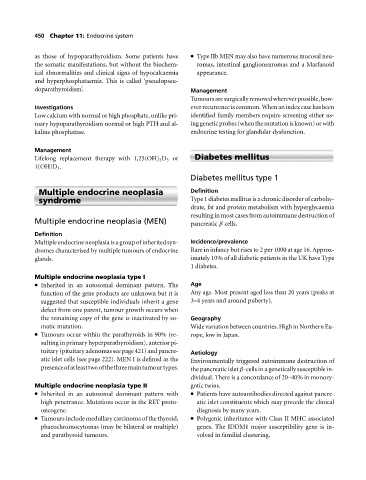Page 454 - Medicine and Surgery
P. 454
P1: FAW
BLUK007-11 BLUK007-Kendall May 25, 2005 8:5 Char Count= 0
450 Chapter 11: Endocrine system
as those of hypoparathyroidism. Some patients have Type IIb MEN may also have numerous mucosal neu-
the somatic manifestations, but without the biochem- romas, intestinal ganglioneuromas and a Marfanoid
ical abnormalities and clinical signs of hypocalcaemia appearance.
and hyperphosphataemia. This is called ‘pseudopseu-
doparathyroidism’. Management
Tumoursaresurgicallyremovedwhereverpossible,how-
Investigations everrecurrenceiscommon.Whenanindexcasehasbeen
Low calcium with normal or high phosphate, unlike pri- identified family members require screening either us-
mary hypoparathyroidism normal or high PTH and al- inggeneticprobes(whenthemutationisknown)orwith
kaline phosphatase. endocrine testing for glandular dysfunction.
Management
Lifelong replacement therapy with 1,25(OH) 2 D 3 or Diabetes mellitus
1(OH)D 3 .
Diabetes mellitus type 1
Multiple endocrine neoplasia Definition
syndrome Type 1 diabetes mellitus is a chronic disorder of carbohy-
drate, fat and protein metabolism with hyperglycaemia
resulting in most cases from autoimmune destruction of
Multiple endocrine neoplasia (MEN) pancreatic β cells.
Definition
Multiple endocrine neoplasia is a group of inherited syn- Incidence/prevalence
dromes characterised by multiple tumours of endocrine Rare in infancy but rises to 2 per 1000 at age 16. Approx-
glands. imately 10% of all diabetic patients in the UK have Type
1 diabetes.
Multiple endocrine neoplasia type I
Inherited in an autosomal dominant pattern. The
Age
function of the gene products are unknown but it is Anyage. Most present aged less than 20 years (peaks at
suggested that susceptible individuals inherit a gene 3–4 years and around puberty).
defect from one parent, tumour growth occurs when
the remaining copy of the gene is inactivated by so- Geography
matic mutation. Widevariationbetweencountries.HighinNorthernEu-
Tumours occur within the parathyroids in 90% (re- rope, low in Japan.
sulting in primary hyperparathyroidism), anterior pi-
tuitary (pituitary adenomas see page 421) and pancre- Aetiology
atic islet cells (see page 222). MEN I is defined as the Environmentally triggered autoimmune destruction of
presenceofatleasttwoofthethreemaintumourtypes. the pancreatic islet β-cells in a genetically susceptible in-
dividual. There is a concordance of 20–40% in monozy-
Multiple endocrine neoplasia type II gotic twins.
Inherited in an autosomal dominant pattern with Patients have autoantibodies directed against pancre-
high penetrance. Mutations occur in the RET proto- atic islet constituents which may precede the clinical
oncogene. diagnosis by many years.
Tumours include medullary carcinoma of the thyroid, Polygenic inheritance with Class II MHC associated
phaeochromocytomas (may be bilateral or multiple) genes. The IDDM1 major susceptibility gene is in-
and parathyroid tumours. volved in familial clustering.

